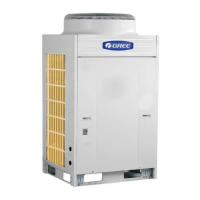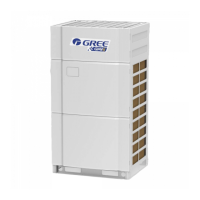
Do you have a question about the Gree GMV-Pdm224W/NaB-M and is the answer not in the manual?
| Model | GMV-Pdm224W/NaB-M |
|---|---|
| Category | Inverter |
| Cooling Capacity | 22.4 kW |
| Heating Capacity | 25.0 kW |
| Power Supply | 380-415V/3Ph/50Hz |
| Refrigerant | R410A |
| Rated Cooling Power Input | 7.0 kW |
| Rated Heating Power Input | 6.8 kW |
| Operating Temperature Range (Cooling) | -5°C to 48°C |
| Operating Temperature Range (Heating) | -15°C to 24°C |
| Outdoor Unit Weight | 120 kg |
| Noise Level (Indoor Unit) | 45 dB(A) |
Covers Outdoor Unit models and their specifications.
Explains model naming conventions for outdoor units.
Lists the various functions of the air conditioning units.
Provides detailed technical specifications for outdoor units.
Illustrates the refrigerant piping for specific models.
Overview of the unit's control system.
Visualizes the unit's operational logic.
Visualizes the outdoor unit's operational logic.
Details operation and features of the Y512 remote controller.
Details operation and features of the YB1FA remote controller.
Operation and features of specific wired controllers.
Operation and features of the XK02 wired controller.
Describes the capabilities of the regional controller.
Details the regional controller's interface and buttons.
Explains the interpretation of the regional controller's display.
Guidelines for connecting regional controllers.
Outlines the capabilities of the smart zone controller.
Details the smart zone controller's interface and buttons.
Explains the interpretation of the smart zone controller's display.
Illustrates the system network configuration.
Procedures for installing and testing the controller.
Functions and operation of the ZJ7011 controller.
Functions and operation of the CE51-24/E(M) controller.
Steps for installing the centralized controller.
Guidelines for connecting the controller to the system.
Details on connecting communication modules.
An example installation scenario for the system.
Overview and functions of the remote monitoring system.
Integration details for Building Management Systems.
Explanation of the gate-control feature's functionality.
Describes how the gate control mechanism operates.
Step-by-step instructions for installing the detection control board.
Highlights essential steps for proper installation.
Crucial safety guidelines before commencing installation.
Guidance on outdoor unit placement for side air outlet configuration.
Criteria for choosing an appropriate installation location.
Provides outline dimensions for the units.
Specifies required spacing around the outdoor unit.
Addresses environmental factors impacting installation.
Guidelines for installing refrigerant piping.
Limits on piping length and height variations.
Details on selecting appropriate pipe diameters.
Guidance on choosing Y-type branch pipes.
Piping selection between outdoor unit modules.
Visual representation of outdoor unit piping connections.
Specifications for oil trap installation.
Steps for installing refrigerant piping.
Core principles for proper piping installation.
Procedures for installing metal embedded pipes.
Guidelines for securing refrigerant piping.
Procedures for handling and preparing pipes.
General steps for refrigerant piping installation.
Procedures for brazing copper pipes.
Steps for cleaning refrigerant piping.
Procedures for pressure testing and leak detection.
Guidelines for insulating refrigerant pipes.
Steps for system vacuuming.
Calculating and adding refrigerant.
Material specifications for condensate pipes.
Critical aspects of condensate pipe installation.
Testing the condensate pipe system.
Heat insulation guidelines for pipes.
Safety guidelines for electrical work.
Electrical component specifications.
Diagrams illustrating electrical wiring.
Importance of system debugging for VRF units.
List of necessary tools for engineering debugging.
Detailed steps for the engineering debugging process.
Pre-debugging checks and environmental inspection.
Step-by-step debugging procedures.
Specific debugging steps for cooling mode.
Specific debugging steps for heating mode.
Key parameters and reference values for system debugging.
Common issues and their solutions.
Troubleshooting communication system problems.
Troubleshooting abnormal system pressure issues.
Diagnosing abnormal discharge temperature.
General troubleshooting guide.
Explanations of indoor unit error codes.
Outdoor unit mainboard LED error indicators.
Method to display the count of indoor units.
Visual troubleshooting workflow.
Troubleshooting steps for high-pressure protection.
Troubleshooting steps for low-pressure protection.
Troubleshooting exhaust temperature errors.
Troubleshooting communication system failures.
Troubleshooting temperature sensor issues.
General diagnosis for sensor-related issues.
Troubleshooting procedures for no power.
Troubleshooting AC contactor problems.
Specific troubleshooting for E5 error.
Resolution steps for E5 protection errors.
Troubleshooting PFC protection issues.
Troubleshooting IPM protection errors.
Troubleshooting trip errors.
Addressing radiator superheat protection issues.
Troubleshooting DC overvoltage protection.
Overview of the power distribution system.
Key electrical components and their function.
Electrical wiring schematics for the system.
Resistance values for 15kΩ temperature sensors.
Resistance values for 20kΩ temperature sensors.
Resistance values for 50kΩ temperature sensors.
Specifications for high-pressure sensors.
Specifications for low-pressure sensors.
Emergency procedures for module failure.
Steps for disassembling and assembling outdoor unit components.
Exploded views and parts list for outdoor units.











